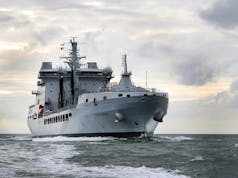The US Navy have taken delivery of the final Block II Super Hornet, closing out a run of 322 one-seater F/A-18Es and 286 two-seated F/A-18Fs.
“Aircraft E322 will leave Boeing’s production line and head straight to Strike Fighter Squadron (VFA) 34 based in [Naval Air Station] Oceana,” explained Cmdr. Tyler Tennille, of Defense Contract Management Agency (DCMA) in a news release from the service.
“When the Super Hornets first came online, they were a game changer,” he explained, pointing to the Block II’s Active Electronically Scanned Array (AESA) radar as well as larger displays, upgraded sensors and avionics, and increased range and capability to employ an arsenal of precision weapons that delivered advanced lethality and mission flexibility for the service.
According to Boeing:
“The robust airframe was built with an open mission systems architecture, which has enabled easy integration of new weapons and technologies. The Block II Super Hornet serves as the Navy’s responsive aircraft, fully capable across the full mission spectrum which includes: air superiority, fighter escort, reconnaissance, aerial refueling, close air support, air defense suppression, and day/night precision strike.
This aircraft has stood strong as the backbone of the Navy’s carrier air wing, and has proven itself repeatedly during numerous operations where it has been the preeminent platform performing multiple missions, sometimes rapidly reconfiguring on the fly. Even though it is substantially larger – roughly 7,000 pounds heavier and a 50 percent higher range, the Super Hornet delivered with fewer parts and lower maintenance demands than its predecessor, the Hornet.”
It is understood that the U.S. Navy will procure 72 Block III Super Hornet aircraft between fiscal years 2019 and 2021. Boeing is expected to deliver the Block III test jets to the US Navy as early as late spring, where subsequent testing will commence at both NAS Patuxent River and Naval Air Weapons System China Lake.
This latest version of the Super Hornet includes an advanced cockpit system; advanced network infrastructure; reduced radar cross-section; and a 10,000-flight hour lifespan.













Part of me thinks we should buy some of these.
Sell our Tranche 1 Typhoons and reduce the F35B order to, say, 80 planes (4 squadrons totalling 48 plus a 12-plane OCU and then 20 spares) and use the money saved/generated to buy 60 or so F/A-18 Super Hornets. Would be cheap yet still very capable, and would boost our aircraft numbers quite a bit. Could get an additional 3 squadrons from that.
Would take our squadron numbers up – 8 for RAF plus 4 for FAA:
– 5 x Typhoon squadrons
– 3 x Super Hornet squadrons
– 4 x F35B squadrons
I cant deny that the SuperHornet would make an interesting choice of Fighter for the RAF,but realistically what does it offer that cant be fulfilled by the Typhoon or even the F35b,bearing in mind the SH would have minimal UK content if any,how would our Industry benefit ?.
There are a few benefits.
1) Numbers. We can get more planes and bulk out the RAF’s fighter fleet.
2) Growler. As part of the order we could include a squadron of the E/A-18 Growler for ECR/EW role.
3) Anti-shipping. Super Hornets are integrated for Harpoon (and Block II) ALand LRASM so either of those missile choices forcan interim would require no integration.
I agree, there would be no benefit to UK industry. Chances are Boeing wouldn’t allow us to build them on licence, though worth a try.
I also agree this shouldn’t be necessary. I’d rather buy another 40-60 Typhoons to replace the Tranche 1s and grow the fleet as well as buy all 138 F35s, but financial constraints make the first impossible and the second unlikely.
With Steve R on this. I see no other realistic way to increase numbers.
Interesting points Steve – (1) Numbers,always going to be a bone of contention I think,what constitutes enough,what constitutes too few,if you wanted to baulk out your Fighter Fleet the cost of each Aircraft would be important.As costs are pretty hard to verify it seems that the FA18E/F comes in at the cheaper end of the scale but you need to factor in a new logistical chain,training and maintenance etc.(2) Agree the Growler would make a valuable dedicated EW/ ECR/SEAD asset but how much of its role can be covered by the F35b ?.(3) Anti-Shipping is another important role that should be covered by either F35b or Typhoon,in the case of F35b more in the future as more suitable weapons become available,there are off the shelf options for Typhoon too but FA18 wise id guess the same Harpoons can be shared with the P8 making some economies.All in all everything comes down to funding (or lack of) do you really need a Typhoon to Bomb a Militia in uncontested Airspace over the Desert,i don’t think so.Personally id still go for the Gripen as it still offers something different plus much cheaper operating costs, but if a Superbug can be purchased for the same money I wouldn’t argue with that !.
If only they would install the uprated GE414 enhanced performance engine (EPE). That would increase the F414-GE-400’s power output from 22,000 lbs to 26,400 lbs. Now that would make the Super Hornet a beast in ACM.
No doubt something we could incorporate should we choose to go down this route for both the F/A-18E/F Super Hornet and the EA-18G Growler.
https://www.geaviation.com/sites/default/files/datasheet-F414-Enhanced.pdf
A good deal could be had on the back end of Germany’s order?
“The US has said it wants to borrow a record $3tn (£2.4tn) in the second quarter, as coronavirus-related rescue packages blow up the budget.
The sum is more than five times the previous quarterly record, set at the height of the 2008 financial crisis.
In all of 2019, the country borrowed $1.28tn. The US has approved about $3tn in virus-related relief, including health funding and direct payouts.
Total US government debt is now near $25tn.”
https://www.bbc.co.uk/news/business-52537938